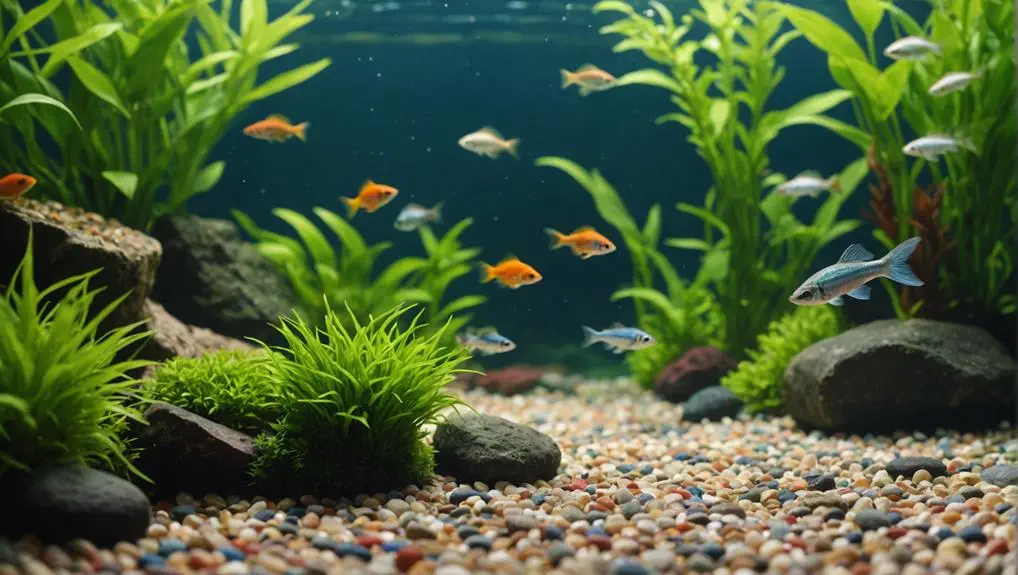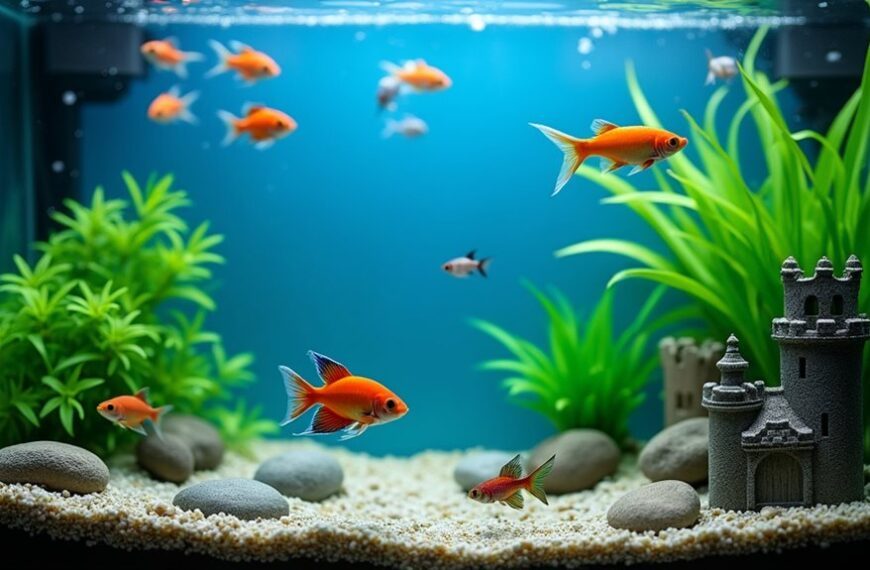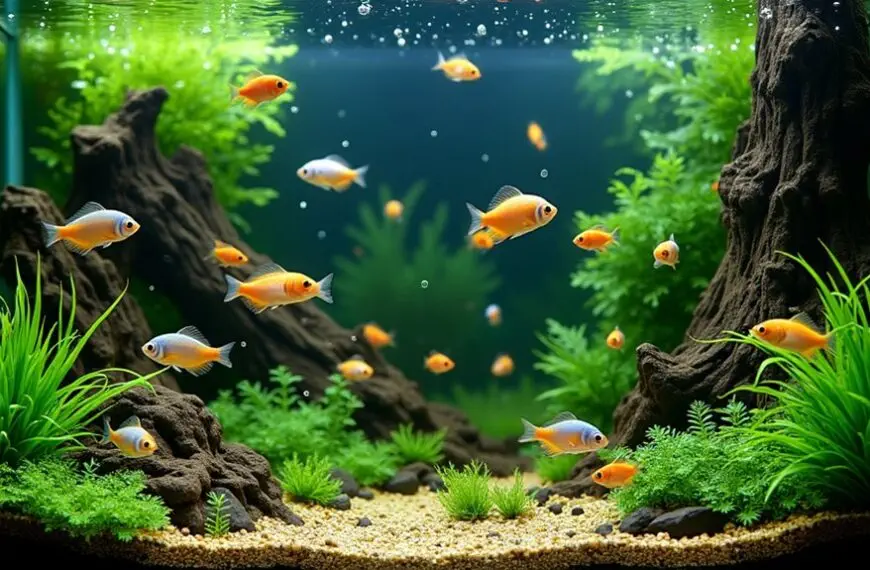Starting your aquarium journey can be exciting and budget-friendly! Great options include colorful rasboras and peaceful tetras, both thriving in schools of six or more. Corydoras are small and friendly, perfect for bottom-dwelling charm. Platies are lively and adaptable, while barbs add a bit of spunky flair with their semi-aggressive nature. If you're up for some character, consider bolivian cichlids or even kuhli loaches for their unique antics. And don't forget about the classic goldfish—they're low-maintenance but need a bit more space. Stick around, and you'll discover even more fascinating choices for your aquatic adventure!
Contents
Rasboras
Rasboras, with their vibrant colors and lively schooling behavior, are a fantastic addition to any new aquarium owner's setup.
These small schooling fish, like the harlequin and lambchop rasbora, typically grow to about 2 inches, making them perfect for community tanks. They thrive in groups of six or more, creating a dazzling display as they dart around your tank, showcasing their peaceful temperament that enhances harmony in your aquarium.
Rasboras aren't just pretty faces; they're also easy to care for. As long as you maintain proper water conditions, you'll find they adapt well to their environment. You can easily find them at your local pet store, and their compatibility with other community fish, like tetras and corydoras, makes them a great choice for a harmonious setup.
Plus, their budget-friendly nature means you won't have to break the bank to enjoy their beauty.
Imagine watching these active swimmers bring your aquarium to life, all while knowing you've created a welcoming home for them.
Common Goldfish
For those looking to expand their aquarium with a classic choice, common goldfish are a popular option. These budget-friendly fish can grow up to 12 to 14 inches long, so they need at least 30 gallons of water each for proper growth. Goldfish are known for their resilience and adaptability, making them perfect for beginners in aquarium keeping, especially when considering their care requirements.
Don't worry, though; common goldfish are resilient and low-maintenance.
While they can happily coexist in community tanks, it's often best to keep them in a single-species setup. This helps reduce any aggressive behavior toward their tank mates.
Goldfish thrive on a diet of spirulina algae, vegetables, and low-protein foods, which keeps them healthy and vibrant. Just remember, they can be quite the messy eaters, producing a fair amount of waste. That means you'll need to commit to frequent water changes to keep their home clean and happy.
Adding common goldfish to your aquarium can bring joy and color to your space. Plus, watching them swim gracefully can be a wonderful, calming experience.
Tetras
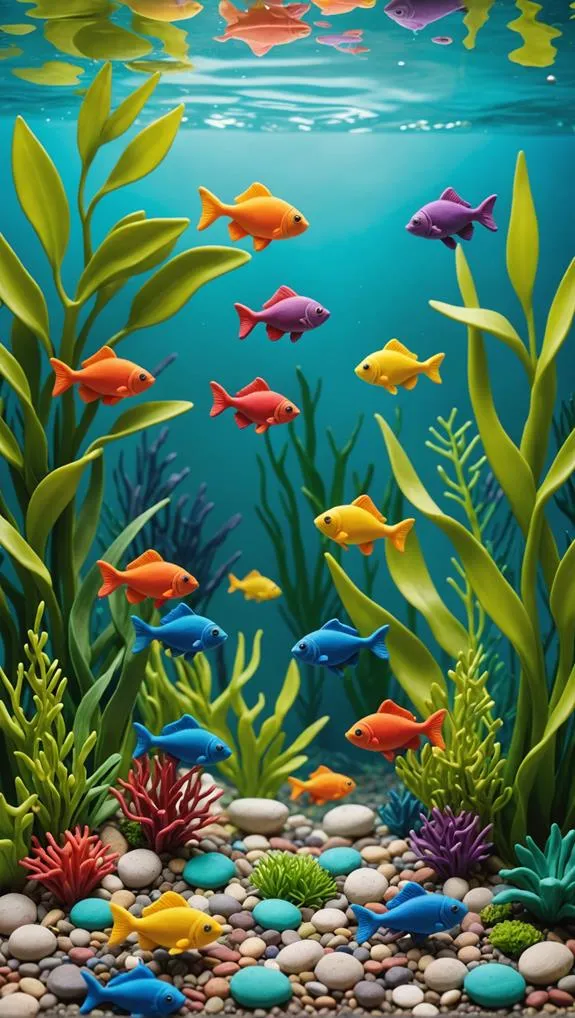
Tetras are some of the most colorful and peaceful fish you can add to your new aquarium. Their small size and adaptability make them ideal for beginners, fitting well in smaller tanks of around 10 gallons.
These little guys love to hang out in groups, so you'll want to get at least six to see their lively schooling behavior in action. Plus, their vibrant colors will light up your tank, making it feel like an underwater party!
For more on beginner-friendly fish, check out this popular beginner fish guide.
Colorful and Peaceful Species
In the vibrant world of freshwater aquariums, few fish match the charm and beauty of tetras. These colorful fish are perfect for anyone looking to create a lively community tank.
Neon tetras, with their stunning blue and red hues, grow to about 1.5 inches and should be kept in schools of six or more. This not only enhances their vibrant colors but also highlights their peaceful nature, making them some of the best beginner pets for new aquarium owners.
Cardinal tetras offer a similar look but sport a brighter red stripe, thriving in slightly acidic water. Both types prefer temperatures between 72°F and 80°F and appreciate a well-planted tank, where they feel secure and can even breed.
Tetras are incredibly hardy fish, which means they can adapt well to various conditions. Their gentle nature makes them compatible with other peaceful fish like rasboras, danios, and corydoras, adding to the biodiversity of your aquarium.
Schooling Behavior Importance
Creating a vibrant community tank isn't just about adding colorful fish; it's also about understanding their social needs. Take neon tetras, for instance. These schooling fish thrive best in groups of at least six. When you keep them in a minimum group size, you'll notice their vibrant colors pop and their swimming becomes more lively. It's like throwing a party where everyone's invited!
Schooling isn't just for show; it plays a vital role in their well-being. When tetras have friends around, they feel secure, which reduces stress. This is especially important, as inadequate schooling can lead to lethargy and health issues. Imagine a shy fish left alone—no fun at all!
Plus, having multiple tetras helps distribute aggression, making it easier for peaceful species to coexist in your community tanks. You'll see more social interactions, too! Watching them dart around together is like seeing a synchronized dance, turning your aquarium into a lively spectacle.
Corydoras
If you're looking for a delightful addition to your new aquarium, Corydoras are an excellent choice. These small, friendly fish typically grow to only 1-3 inches, making them perfect for a community aquarium. Plus, they thrive in groups of three to six, so you can enjoy their social interactions as they scavenge for food together!
Corydoras come in over 160 species, with popular varieties like bronze, albino, and panda corys. Their peaceful nature makes them great companions for other gentle fish. When feeding your corydoras, think sinking pellets, algae, and detritus to keep them happy and healthy.
These little guys prefer a soft substrate to protect their sensitive barbels, so make sure your tank has a comfortable bottom. They thrive in water temperatures between 72-82°F and a pH of 6.5-7.8, making them adaptable to various water parameters.
Adding Corydoras to your aquarium not only enhances the environment but also brings joy to your fish-keeping experience. So, prepare to watch these charming scavengers bring life to your underwater world!
Platies
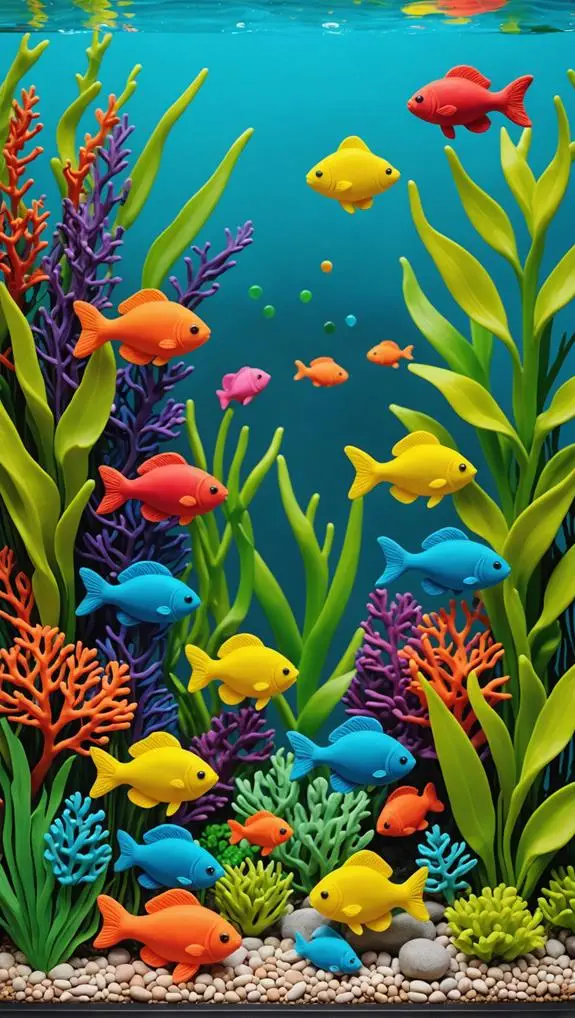
Looking for a colorful and lively addition to your aquarium? Platies might just be the perfect choice! These stunning little freshwater fish usually grow up to about 3 inches and come in a rainbow of vibrant colors.
They're not just easy on the eyes; they're also incredibly adaptable to many tank sizes and thrive in a pH range of 7.0.
As a beginner fish, platies have minimal care requirements, making them a fantastic option for those just starting out. They're omnivorous, so you can feed them a variety of community fish foods without breaking the bank.
Plus, they love being part of a group, so make sure to keep at least three together to help reduce stress and encourage their natural behaviors.
Platies are social creatures and will bring life to your community tank. Just imagine watching them dart around, showcasing their colors!
With their robust health and cheerful demeanor, these fish aren't just budget-friendly; they're a joy to care for. So, get ready to welcome some platies into your aquarium and watch your underwater world come alive!
Betta Fish
After adding platies to your aquarium, consider introducing betta fish for a stunning display of color and personality. Betta fish, known for their vibrant colors and unique fin shapes, can truly elevate your tank's aesthetics.
They thrive in a minimum tank size of 5 gallons and require a heater to keep the water at a cozy 78-82°F.
Now, be mindful: while bettas are beautiful, they can also be a bit territorial, especially the males. It's best not to house them with other male bettas, but they can happily coexist with non-aggressive species in larger community tanks.
Their diet is relatively simple, consisting mainly of specially formulated betta pellets, with occasional small floating foods or frozen treats to keep things interesting.
Creating a well-decorated environment with hiding spots will help your bettas feel secure and encourage their playful nature.
Barbs
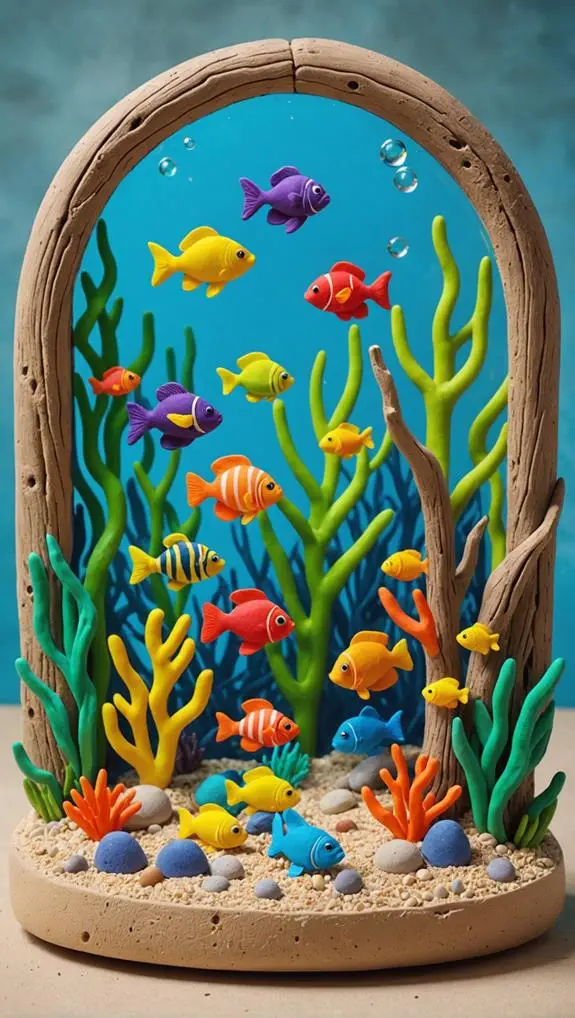
Barbs are an exciting addition to any community aquarium, bringing both color and lively energy to your tank.
These semi-aggressive schooling fish, like tiger and cherry barbs, typically grow to about 3 to 4 inches. To keep the peace, it's best to house them in groups of at least six. Trust me, they'll thrive in a well-maintained tank with slightly acidic to neutral pH levels and temperatures between 72-79°F.
You'll love how compatible they're with other community fish, such as rasboras and tetras. Just remember to keep them away from long-finned species; their nippy behavior can lead to some fin-tastrophes!
To keep your barbs healthy and showcasing their vibrant colors, feed them a balanced diet consisting of high-quality flakes, pellets, and occasional treats like frozen or live foods.
These little guys appreciate variety, just like you do in your meals! As you watch them dart around your aquarium, you'll realize they're not just fish; they're a lively part of your aquatic family.
Bolivian Cichlids
If you're looking to add some personality to your aquarium, Bolivian cichlids might just be your new best friends.
They thrive in slightly alkaline waters and love a cozy, well-planted environment where they can hide and explore.
Plus, with their peaceful nature, these colorful fish get along well with many other community species, making them a fantastic centerpiece for your tank!
Ideal Tank Conditions
Creating the ideal tank conditions for your Bolivian cichlids is essential for their health and happiness. Start with a tank size of at least 20 gallons. This gives them enough space to swim and establish their territorial behavior. Aim for a water temperature between 72°F and 79°F, and maintain a pH level between 7.0 and 8.0. They're pretty adaptable, but stability is key!
Now, let's talk about water quality. Bolivian cichlids are sensitive to poor water conditions, so regular water changes are a must. Good filtration will help keep the water clean and safe. You wouldn't want to live in a messy room, right?
A well-structured environment is also crucial. Add plants, rocks, or caves for hiding spots. This not only reduces stress but also makes your tank look like a cozy little home for them.
Social Compatibility Factors
Bolivian cichlids aren't just beautiful additions to your aquarium; they're also quite sociable.
These charming fish thrive in community tanks, and their peaceful nature makes them perfect companions for other non-aggressive fish species. If you're considering adding them to your setup, keep these factors in mind:
- Small Groups: They do best in pairs or small groups, enhancing their social interactions and allowing them to school together.
- Hiding Spots: Providing plenty of hiding spots helps them feel secure while promoting harmony among tank mates. Think of it as giving them cozy nooks to chill in!
- Compatible Tank Mates: They coexist beautifully with other peaceful fish like tetras and rasboras, creating a lively, engaging environment.
When you maintain your tank properly and ensure the right conditions, you'll foster a balanced habitat for your Bolivian cichlids and their friends.
Remember, happy fish make for a happy aquarium!
Kuhli Loaches
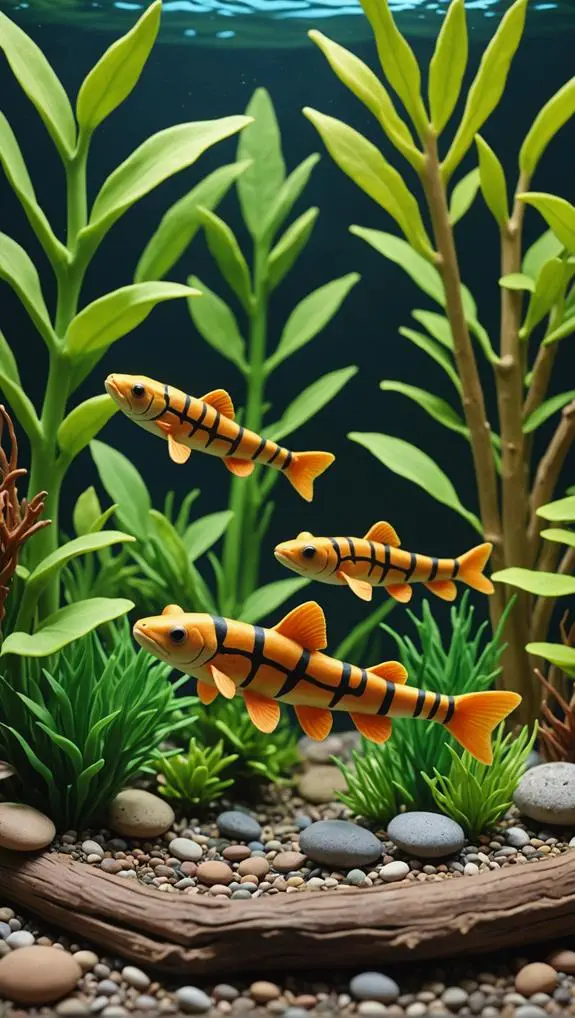
Kuhli loaches are a fantastic choice for beginner aquarium owners looking to add unique charm to their tanks. These little guys, resembling small eels, usually grow to about 4 inches and thrive in groups of three to six. Keeping them together encourages their shy behavior, making your tank come alive with their playful antics.
As nocturnal bottom dwellers, kuhli loaches need plenty of hiding spots to feel secure. Think caves, plants, or even driftwood—anything that provides them with places to dart in and out.
They're peaceful fish, making them perfect for community tanks where they can coexist with other species.
Feeding your kuhli loaches is simple; they're scavengers by nature. Offer them a varied diet of sinking foods to keep them healthy and happy. Regularly observing their behavior can help you ensure they're comfortable in their new home.
Watching them explore can be quite the entertaining spectacle! So, if you're looking to add a touch of whimsy to your aquarium while keeping things budget-friendly, kuhli loaches are definitely worth considering. They'll bring joy not just to your tank, but to you as a dedicated fish keeper!
Angelfish
When you think about adding angelfish to your aquarium, remember they need a comfy home—ideally a tank of at least 55 gallons.
These stunning fish are great for community tanks, but you'll want to keep an eye on their interactions, especially if they're sharing space with smaller fish that might end up as a snack!
With the right care, feeding, and compatibility, these graceful swimmers can truly shine in your aquatic setup.
Ideal Tank Size
Choosing the right tank size for angelfish is crucial for their health and happiness. These stunning fish need ample space to thrive, so let's get into it!
- Minimum Size: Aim for at least a 55-gallon tank. This provides enough room for your angelfish to swim and grow, as they can reach up to 6 inches tall and wide.
- Vertical Space: Opt for a taller tank! Angelfish love to swim vertically, so a tank that's more vertical than horizontal will keep them happy.
- Water Quality: Keeping water quality high is essential. A larger tank dilutes waste better, and with proper filtration, you'll maintain a clean environment for your fish.
Compatible Tank Mates
Finding the right tank mates for your angelfish can enhance your aquarium's beauty and balance. You'll want to choose easy-to-keep fish that thrive alongside these elegant swimmers. Angelfish do well in a community tank with small fish like neon tetras, harlequin rasboras, and corydoras, as long as your tank size is at least 55 gallons.
Remember, a spacious environment helps minimize territorial disputes.
It's important to ensure your tank mates are compatible in terms of water parameters. Keep the pH between 7.0 and 7.8, and maintain a temperature of 76-82°F for the best results.
Also, due to their semi-aggressive nature, avoid long-finned species or smaller fish that might end up as a snack. You wouldn't want your angelfish to develop a taste for tiny tank mates!
Observe the social dynamics closely; angelfish can have varying behaviors that might affect your community tank harmony.
By thoughtfully selecting compatible tank mates, you create a vibrant underwater world that not only serves your angelfish but also delights anyone who gazes into your aquarium.
Happy fishkeeping!
Care and Feeding
Maintaining the health of your angelfish goes hand in hand with selecting compatible tank mates.
To truly care for and come to know your angelfish, you'll want to meet their specific needs. Here's what you should focus on:
1. Water Quality: Regular water changes to keep the environment fresh are a must—aim for about 25% weekly.
Angelfish are sensitive to poor water, so don't skip this step!
2. Temperature and pH: Keep the water between 76-82°F and ensure a pH of 6.5 to 7.5.
This helps your active fish thrive and prevents stress.
3. Diet: Feed them a mix of high-quality fish food, like pellets and flakes, along with occasional treats like freeze-dried options.
Variety is key to their happiness and health!
Frequently Asked Questions
What Is the Best Starter Fish for a New Aquarium?
When choosing the best starter fish, consider guppies, neon tetras, or platies. They thrive in suitable tank conditions, have ideal water parameters, and are compatible with various species, ensuring a lively, healthy aquarium environment for everyone.
What Is the First Fish to Put in a New Aquarium?
When starting your aquarium, consider hardy fish like guppies. They thrive despite fluctuating water parameters. Remember to acclimate them properly, monitor the cycle process, and ensure fish compatibility for a thriving aquatic environment.
What Is the Friendliest Fish for an Aquarium?
When choosing the friendliest fish for your aquarium, consider community fish like guppies and neon tetras. Their peaceful nature, vibrant colors, schooling behavior, and size variations make them easy-care, active swimmers that enhance tank compatibility.
What Is the Best Fish to Add to a New Tank?
Choosing the best fish for your new tank isn't rocket science! Start with guppies or neon tetras, and remember tank cycling tips, fish compatibility charts, and water quality testing for a thriving community.
Final Thoughts
In the end, choosing budget-friendly fish can make your aquarium journey rewarding and fun. Imagine a cozy evening, watching your platies dance around the tank as your kids giggle at the curious corydoras scuttling along the bottom. These little moments create lasting memories and spark a love for aquatic life. So go ahead, pick your favorites, and dive into this colorful adventure! Your new underwater friends are waiting to bring joy and life to your home.

